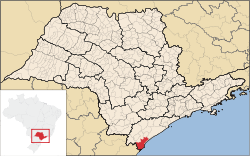Cananéia
Cananéia | |
|---|---|
| Municipality of Cananéia | |
Aerial view of Ariri Mother Church Historic Center Stone House Mandira Quilombola Community Beach at the Ilha do Cardoso | |
 Location in São Paulo | |
| Coordinates: 25°00′53″S 47°55′36″W / 25.01472°S 47.92667°W | |
| Country | |
| Region | Southeast |
| State | |
| Founded | 12 August 1531 |
| Government | |
| • Mayor | Gabriel Guimarães (GUIMA) (PV) |
| Area | |
• Total | 1,242.010 km2 (479.543 sq mi) |
| Elevation | 8 m (26 ft) |
| Population (2020)[1] | |
• Total | 12,541 |
| • Density | 11.4/km2 (30/sq mi) |
| Time zone | UTC−3 (BRT) |
| HDI (2010) | 0.720 – high[2] |
| Website | Official website |
Cananéia is the southernmost city in the state of São Paulo, Brazil, near where the Tordesilhas Line passed. The population in 2020 was 12,541 and its area is 1,242.010 km². The elevation is 8 m. The city of Cananéia is host to the Dr. João de Paiva Carvalho research base belonging to the Oceanographic Institute of the University of São Paulo.
Cananéia is considered by some Portuguese and Spanish historians to be the oldest city in Brazil,[3][4][5] five months before the founding of São Vicente, but due to the lack of official documentation proving this fact, São Vicente is officially the oldest city in Brazil. The Historic Center of Cananéia, listed by CONDEPHAAT, still preserves the architectural styles adopted by the first houses and churches from the colonial period until the end of the 19th century. The beaches also attract thousands of people in high season, and Ilha do Cardoso has several trails and waterfalls, as well as several archaeological sites. Festivals, cuisine and handicrafts are also attractions apart from the city, whose main sources of income are fishing and tourism.
Due to its natural beauty and rich ecosystem, it is listed as a Natural Heritage Site by UNESCO.[5]
History
[edit]Founded in 1531, Cananéia is considered by some to be the oldest city in Brazil (5 months before the foundation of São Vicente) but due to the lack of official documentation proving this fact, São Vicente is officially the oldest city in Brazil. The historic center of Cananéia still preserves the architectural styles adopted by the first houses from the colonial period to the end of the 19th century.
Conservation
[edit]The municipality contains the 13,500 hectares (33,000 acres) Ilha do Cardoso State Park, created in 1962.[6] It contains part of the Tupiniquins Ecological Station.[7] It contains the 1,176 hectares (2,910 acres) Mandira Extractive Reserve, established in 2002.[8] The municipality contains the 1,662 hectares (4,110 acres) Taquari Extractive Reserve, created in 2008.[9] It contains the 1,128 hectares (2,790 acres) Ilha do Tumba Extractive Reserve, also created in 2008.[10] It contains the 1,243 hectares (3,070 acres) Itapanhapima Sustainable Development Reserve, created at the same time.[11]
Media
[edit]In telecommunications, the city was served by Companhia de Telecomunicações do Estado de São Paulo until 1975, when it began to be served by Telecomunicações de São Paulo.[12] In July 1998, this company was acquired by Telefónica, which adopted the Vivo brand in 2012.[13]
The company is currently an operator of cell phones, fixed lines, internet (fiber optics/4G) and television (satellite and cable).[13]
See also
[edit]References
[edit]- ^ IBGE 2020
- ^ "ranking-idhm-2010.pdf" (PDF). United Nations Development Programme (UNDP). Archived from the original (PDF) on July 8, 2014. Retrieved August 1, 2013.
- ^ Díaz de Guzmán, Ruy; Tieffemberg, Silvia (2012). Argentina: historia del descubrimiento y conquista del Río de la Plata. Libros de cátedra. Buenos Aires: Editorial de la Facultad de Filosofía y Letras, Universidad de Buenos AIres. ISBN 978-987-1785-55-1.
- ^ Bueno, Eduardo (1998). Náufragos, traficantes e degredados: As primeiras expedições ao Brasil, 1500-1531 (in Brazilian Portuguese). Objetiva. ISBN 978-85-7302-216-2.
- ^ a b "Visite Cananeia, a primeira cidade brasileira". Governo do Estado de São Paulo. Retrieved 23 November 2024.
- ^ Sobre o Parque (in Portuguese), SAP: Sistema Ambiental Paulista, archived from the original on 2016-09-30, retrieved 2016-11-17
- ^ Unidade de Conservação: Estação Ecológica dos Tupiniquins, MMA: Ministério do Meio Ambiente, retrieved 2016-04-18
- ^ RESEX do Mandira (in Portuguese), ISA: Instituto Socioambiental, retrieved 2016-09-19
- ^ RESEX Taquari (in Portuguese), ISA: Instituto Socioambiental, retrieved 2016-11-21
- ^ RESEX da Ilha do Tumba (in Portuguese), ISA: Instituto Socioambiental, retrieved 2016-11-25
- ^ RDS de Itapanhapima (in Portuguese), ISA: Instituto Socioambiental, retrieved 2016-11-25
- ^ "Creation of Telesp - April 12, 1973". www.imprensaoficial.com.br (in Portuguese). Retrieved 2024-05-26.
- ^ a b "Our History - Telefônica RI". Telefônica. Retrieved 2024-05-26.









